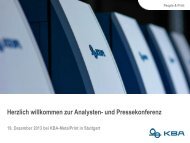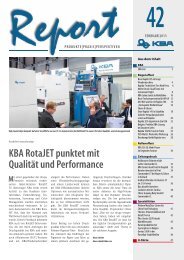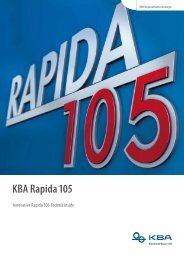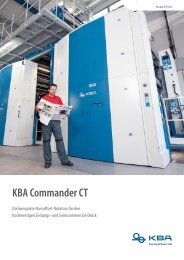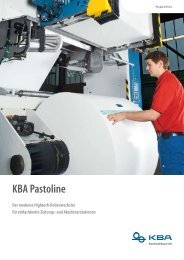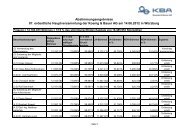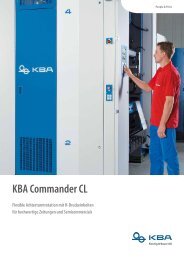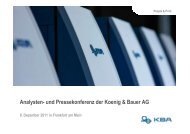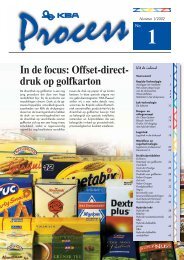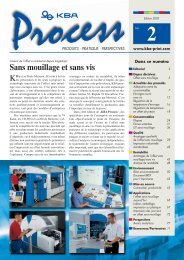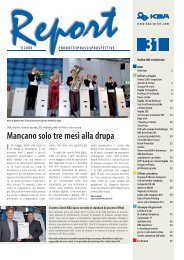Report 36 d,e,f,s,i.qxd:Report - KBA
Report 36 d,e,f,s,i.qxd:Report - KBA
Report 36 d,e,f,s,i.qxd:Report - KBA
You also want an ePaper? Increase the reach of your titles
YUMPU automatically turns print PDFs into web optimized ePapers that Google loves.
the fount solution in a moment’s<br />
aberration was nipped in the bud by<br />
the simple expedient of removing<br />
all alcohol measuring and monitoring<br />
kit. Only ecologically approved<br />
inks based on vegetable oils are run<br />
on the press. The cloth-based washing<br />
system, which dramatically cuts<br />
the consumption of washing agent<br />
compared to a brush-based system,<br />
is a further contribution towards<br />
greener production – as is the LogoTronic<br />
networking software for<br />
press preset. Hans-Martin Heider,<br />
one of the fourth-generation family<br />
members heading the company, is<br />
delighted to report that “As a result,<br />
a lot of the products we print are of<br />
saleable quality from the very first<br />
sheet.”<br />
Closed-loop inline<br />
colour control<br />
To help minimise waste the press<br />
incorporates a QualiTronic colour<br />
control system that scans every<br />
sheet and automatically adjusts<br />
colour density values accordingly.<br />
The press is also linked to a Densi-<br />
Tronic Professional system that<br />
measures colorimetric values in the<br />
measuring strips or directly in the<br />
printed image, and carries out<br />
the relevant adjustments. This continuous,<br />
integrated quality control<br />
package enabled the company to<br />
achieved PSO accreditation in summer<br />
2009.<br />
The economic impact of the<br />
new Rapida 106 became apparent<br />
within a few weeks of its production<br />
start. The average print output<br />
across the board (short and long<br />
runs) climbed well above the<br />
10,000sph mark. Whenever possible<br />
the Rapida 106 is run at its maximum<br />
speed of 18,000sph. Most of<br />
the short- and medium-run work is<br />
Heider Druck’s “ecological printing” logo<br />
reflects its environmental credentials<br />
Even though quality monitoring with QualiTronic colour control eliminates the need for<br />
adjustments at the ink keys, Michael Dörpinghaus still checks the sheets out of sheer habit<br />
For Benjamin Ommerborn, pumping out 18,000 sheets per hour on the Rapida 106 is a cinch<br />
scheduled on this press in order to<br />
make the most of its high-speed job<br />
changes. Its advanced level of automation,<br />
which encompasses plate<br />
changing, suction-ring positioning,<br />
height-adjustable nonstop rollers<br />
and sidelay-free SIS infeed, has<br />
boosted output by almost 40 per<br />
cent compared to its predecessors.<br />
Sustainability does<br />
not preclude finishing<br />
The Rapida 106 offers a raft of additional<br />
benefits over the company’s<br />
previous presses, which<br />
were two-and four-colour B1 (41in)<br />
and B2 (29in) models. For example,<br />
it is possible to apply a special<br />
colour in the fifth printing unit and<br />
a standard aqueous coating in the<br />
coater, or a matt paste in the fifth<br />
unit followed by a matt/gloss aqueous<br />
coating to create a drip-off effect.<br />
So Heider Druck’s ecological<br />
bent certainly doesn’t preclude<br />
value-added finishing options. In<br />
fact the company is keen to move<br />
upmarket, away from high-volume,<br />
low-margin products. Wherever<br />
possible it seeks to provide premium-quality<br />
products expressly tailored<br />
to customers’ needs. This goal<br />
dictates the processes within the<br />
company: the broad range of services<br />
offered encompasses product<br />
design, image processing, editing,<br />
mailing, proofreading, addressing,<br />
numbering (eg for prize draws in<br />
freesheets), inserting and attaching<br />
(eg packets of seeds in or on direct<br />
mail).<br />
Farsighted investment<br />
Heider Verlag is headed by Hans<br />
Heider senior and his third son,<br />
Roberto. Their portfolio encompasses<br />
publications on business and<br />
social politics, books of regional interest<br />
and pictorial volumes. Alongside<br />
ad acquisition the media<br />
Thomas Walder printing one of many<br />
freesheet titles on the Journal tower<br />
An 18,000m² plot of land acquired in the 1950s<br />
offers plenty of room for further growth<br />
services the company also provides<br />
for its print customers include ad<br />
management.<br />
At present Heider has almost<br />
6,000m² (65,000ft²) of production<br />
space at its disposal. Since a plot of<br />
land acquired by Hans Heider senior’s<br />
father is more than three<br />
times as big, there is ample room<br />
for healthy growth. “We are a dynamic<br />
enterprise with ambitious<br />
plans for the future, so it’s good to<br />
have plenty of reserves for future<br />
expansion,” declares Roberto Heider.<br />
The publishing house and printing<br />
plant employ a total of 90<br />
permanent staff, and there are also<br />
part-timers and temps. Print production<br />
normally runs in two shifts,<br />
though this is increased to three<br />
whenever there is a surge in incoming<br />
orders.<br />
Martin Dänhardt<br />
martin.daenhardt@kba.com<br />
<strong>Report</strong> <strong>36</strong> | 2010 27




